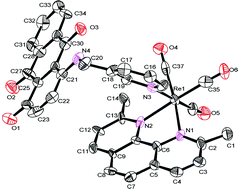Amino-anthraquinonechromophores functionalised with 3-picolyl units: structures, luminescence, DFT and their coordination chemistry with cationic Re(i) di-imine complexes†
Abstract
The syntheses of four new

* Corresponding authors
a
School of Chemistry, Main Building, Cardiff University, Cardiff, Cymru/Wales
E-mail:
popesj@cardiff.ac.uk
Fax: (44) 2920 874030
Tel: (44) 2920 879316
The syntheses of four new

 Please wait while we load your content...
Something went wrong. Try again?
Please wait while we load your content...
Something went wrong. Try again?
J. E. Jones, B. M. Kariuki, B. D. Ward and S. J. A. Pope, Dalton Trans., 2011, 40, 3498 DOI: 10.1039/C0DT01383H
To request permission to reproduce material from this article, please go to the Copyright Clearance Center request page.
If you are an author contributing to an RSC publication, you do not need to request permission provided correct acknowledgement is given.
If you are the author of this article, you do not need to request permission to reproduce figures and diagrams provided correct acknowledgement is given. If you want to reproduce the whole article in a third-party publication (excluding your thesis/dissertation for which permission is not required) please go to the Copyright Clearance Center request page.
Read more about how to correctly acknowledge RSC content.
 Fetching data from CrossRef.
Fetching data from CrossRef.
This may take some time to load.
Loading related content
